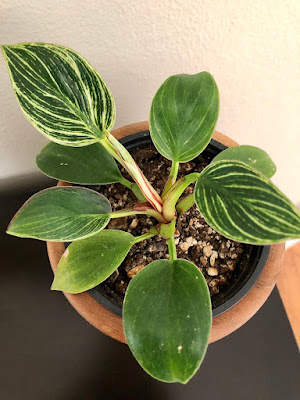Philodendron Birkin is an attractive indoor plant and will grow in subtropical gardens as shaded underplanting.
Philodendron Birkin also called as Philodendron ‘White Wave’, is a cultivated variety of Philodendron Rojo Congo in the genus Philodendron. It is an attractive indoor plant and will grow in subtropical gardens as shaded underplanting.
IDENTIFY PHILODENDRON BIRKIN
Philodendron Birkin has an interesting history, even though it hasn’t been around too long. It came into existence as a spontaneous mutation during the cultivation of Philodendron Rojo Congo. Delighted with the impressive variegation of this unexpected plant, the grower put this beauty into full production.
The plant is famous for its gorgeous, stunning, evergreen foliage. It has dark green leaves with a glossy finish and variegation on its surface. They have hints of green and cream color creatively merged in the form of stripes. The leaves can grow as long as 20 centimeters and are oval-shaped. The height of the mature plant is something that is yet to be confirmed. Different sites have published an estimated height of 50cm - 100cm.
The plant has a perennial life cycle, making it highly durable as ornamental plants. It consist of a crystal called calcium oxalate. These crystals are accumulated in all parts of the body. Thus, on ingestion, taken cause mild to severe symptoms based on the quantity taken. Make sure that you keep the plant away from your children and pets.
PHILODENDRON BIRKIN CARE AND CULTURE
Cultural information should only be used as a guide, and should be to be adapted to suit you. Your physical location; where you grow your plants, how much time you have to devote to their care, and many other factors, will need to be taken into account. Only then can you decide on the cultural methods that best suit you and your plants.
Light:
Philodendron Birkin grows best in bright and indirect sunlight. Exposure to the sunlight can causes a yellowish color in the leaves or a sunburn spot. Artificial light gives best results if natural light is not present.
Rotate your plant periodically to ensure even growth on all sides and dust the leaves often so the plant can photosynthesize efficiently. When dusting the leaves, also take the opportunity to inspect the undersides and keep an eye out for pests.
Temperature:
This plant grows well in normal to warm indoor temperatures 24-27ºC (75-80ºF). They cannot tolerate temperatures which drop below about 13ºC (55ºF).
Substrate and growing media:
Philodendron Birkin grows best in loose, well-drained soil which is rich high in organic matter. It also be grow in 100% sphagnum peat moss and mixtures such as peat-vermiculite or peat-perlite.
The plants benefit from repotting to a larger container when they become root bound and outgrow the original pot. A combination of half soil-based potting mixture and half leaf mould or coarse peat moss is used.
Move the plant into container one size larger only when their roots have completely filed the current one. This is done at any time of year except during the short rest period. After the long rest period the convenient pot size has been reach (probably about 25-30cm (10-12 inch)), an annual spring top-dressing with fresh potting mixture will help to keep the plat healthy. A container with drainage holes to prevent root rot is used. A cachepot is used if a decorative container is without drainage. It is necessary to cover the bottom of a cachepot with pebbles so as to keep the plant above the drainage water.
Watering:
Fertilizer:
Philodendron Birkin are considered heavy feeders. Regular feeding program with a nitrogen fertilizer will increase leaf size and produces a larger, healthier plant. Throughout the months while the plant is actively growing apply standard liquid fertiliser once every two weeks. It's a nice strategy to fertilize more frequently at half strength than to apply one strong dose. Plants which mainly grows in low-light conditions require less fertilization than actively-growing plants. Moist soil requires fertilizers to avoid injury to plant roots.
Pruning:
Since these plants have a neat growing habit with large, separate leaves, you don’t have to prune them or maintain their shape. You can, however, groom with and keep them clean. Always wear gloves when pruning and wash your hands and tools when finished. You don't want to get the sap in your eyes or mouth.
Propagation:
Cutting and layering are popular methods of Philodendron species propagation. Try propagating them during the growing season. A small brown nubs are formed where the leaves meet the stem. These nubs, when in contact with soil or water, will grow roots. There are many ways to propagate this plant, the easiest being to cut a branch just below a root-nub and place it in water with a few pieces of horticultural charcoal to reduce the likelihood of rot. As soon the growth of new leaf takes place it is potted in the rich soil. Similarly it can also be propagated within its own pot by pinning vines at the root-nub to the soil with hairpins or bent wire. The root nub in contact with the soil will sprout new roots in a very short time. When the different parts of Philodendron species are rooted, the plant will greatly profited from misting several times a day.
BUY PHILODENDRON BIRKIN AND RELATED PRODUCTS
BUY ANOTHERS SPECIES AND VARIETIES OF PHILODENDRON GENUS HERE!















COMMENTS